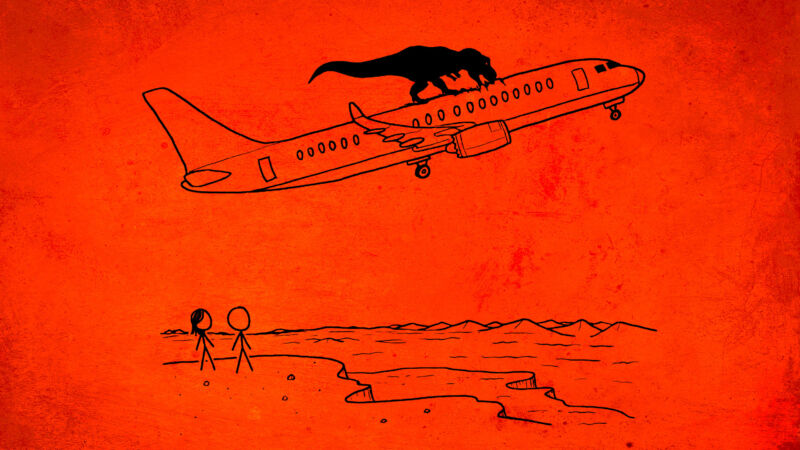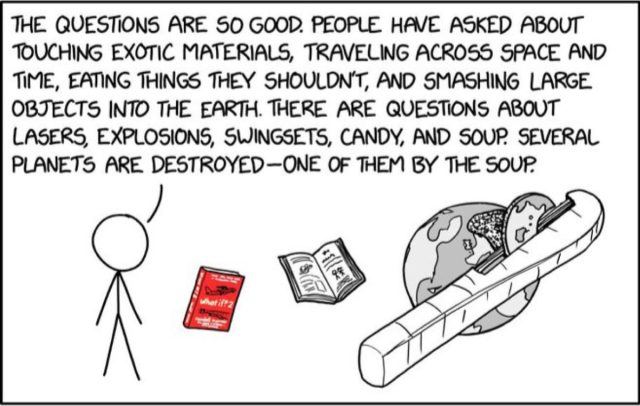
Randall Munroe / Ars Technica
Forget debating the airspeed velocity of an unladen African versus a European swallow. How many pigeons would it take to lift a person seated in a launch chair to the top of the Q1 skyscraper in Australia? Answer: You could probably manage this with a few tens of thousands of pigeons, as long as they don’t get spooked by a passing falcon or distracted by someone with a bag of seeds. That’s just one of many fascinating (and amusing) tidbits to be gleaned from What If? 2, the latest book from cartoonist and author Randall Munroe and the sequel to 2014’s bestselling What If?
Regular Ars readers likely need no introduction to Munroe, or his hugely successful and influential webcomic xkcd. But we’ll give you a brief rundown anyway. Munroe has a degree in physics and worked for NASA’s Langley Research Center as a contract programmer and roboticist. As a student, he often drew charts and maps and “stick figure battles” in notebook margins and decided to scan them and post them to his personal website in 2005. The webcomic got its own website in 2006, when Munroe left NASA to write xkcd full time.
It didn’t take long for xkcd, with its distinctive stick figures, to become a daily staple for scientists, engineers, and online nerds in general. There’s nothing quite like them. Longtime fans know all about the tooltip with the hidden secondary punchline for each cartoon and Munroe’s obsession with possible velociraptor attacks. They spent hours with 2012’s “Click and Drag” and eagerly followed the four-month-long journey of time-lapsed frames that comprised the experimental “Time,” which won the 2014 Hugo Award for Best Graphic Story.
Munroe’s 2012 tribute to the Saturn V rocket inspired scientists to take the “Up-Goer Five Challenge”: explaining their research papers in the most basic language possible. In fact, Munroe ended up writing an entire book, 2015’s Thing Explainer, using only the 1,000 most commonly used words in the English language. (For instance, pencils were “writing sticks,” airplane engines were “sky boat pushers,” and microwave ovens were “food-heating radio boxes.”)
What If? 2 follows the same format as its 2014 predecessor. Munroe selects absurd-sounding reader-submitted questions and attempts to answer them, illustrated with his trademark drawings. Some have relatively short answers, like whether it’s possible to build a sword of solid air. (Answer: Technically, yes, but “it wouldn’t be very strong, it would be hard to sharpen, and it would quickly give your hand frost damage.”) Others get the multi-page treatment, such as whether you could fill an entire church with bananas.

Randall Munroe/xkcd
These are interspersed with “Weird and Worrying” questions, where Munroe doesn’t even answer them; he included them because he thought the question itself was funnier than any answer he could come up with. Case in point: if Harry Potter forgot the location of the invisible entrance to Platform 9-3/4, how long would he have to crash into walls before discovering it? “You could calculate out the answer by counting all the brick walls in the train station,” Munroe told Ars. “But really, I just like the mental image of Harry Potter being, like, ‘All right, it wasn’t the last five, I’m going to try this one now.'”
In short, the book is chock full of even more serious answers to seemingly silly questions. “Even if the answers aren’t useful, knowing them is fun,” Munroe writes in his introduction. What If? 2, for example (the physical book), “weighs as much as the electrons in two dolphins. That information probably isn’t useful for anything, but I hope you enjoy it anyway.”
Ars sat down with Munroe to learn more. Bonus: today’s xkcd is a fun flow chart guide for those who acquire a copy of What If? 2.
Ars Technica: Somehow people got into the habit of asking you these really weird, silly, sometimes impossible, implausible questions. And you started answering them. How exactly did that happen?
Randall Munroe: When I started drawing comics, I was surprised to learn there were so many people who were entertained by the same niche science ideas or funny applications of math to different problems—stuff I laughed at but I didn’t expect anyone else to. Then I put up these comics and found there are a whole bunch of people out there who think about stuff the way I do. That was really cool. But I definitely didn’t expect that people would start thinking of me as the person to settle arguments. I’d get these emails: “Hey, me and my friend have been arguing about this for a while now, and we don’t know how to answer the question. It feels like it’s not a good enough question to bother a real scientist with. But we both agreed you seemed like a great person to send it to.”
Perhaps I should have felt a little bit miffed. Are you implying that I have nothing better to do with my time, that a real scientist has important things to do? But they were also right. I would get these questions, and then six hours later, I’d wake up from a kind of trance, because I’d gone down every research rabbit hole you can imagine. For me, seeing a really interesting question, where you don’t know the answer but you think it might be solvable—it can be like getting a song stuck in your head. You just can’t quite drop it until you figure it out.
So people would have these arguments, and then I’d get sucked in. I’d be like, I think the answer is this, but I can’t prove it. I’m going to try to prove it. So it started off as me just trying to prove that I was right about something to a random person on the Internet. But then I found that I learned so much cool stuff while I was doing it that I thought, man, I should save these answers somewhere and share them with people. And that’s how my What If? blog and book got started.

Randall Munroe/xkcd








